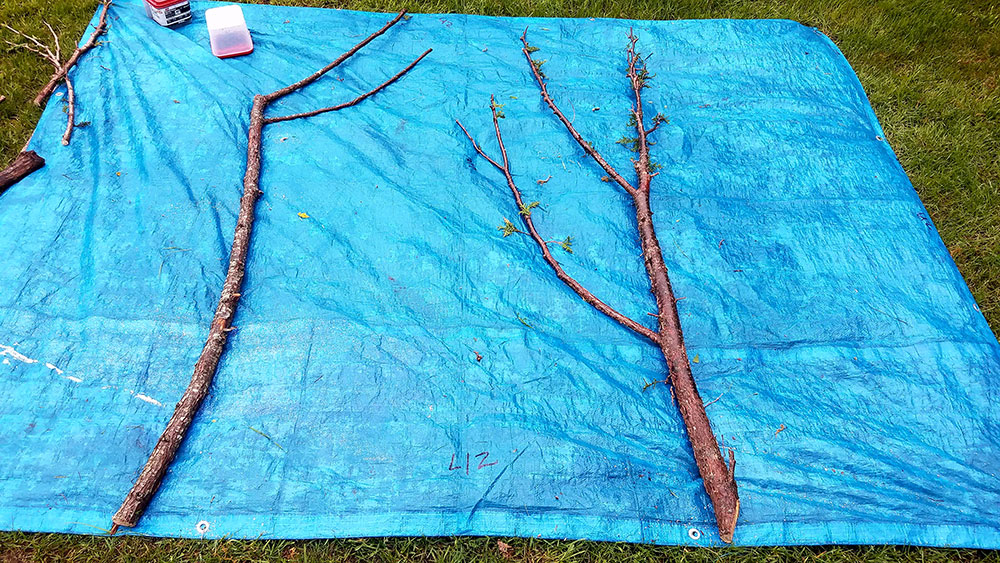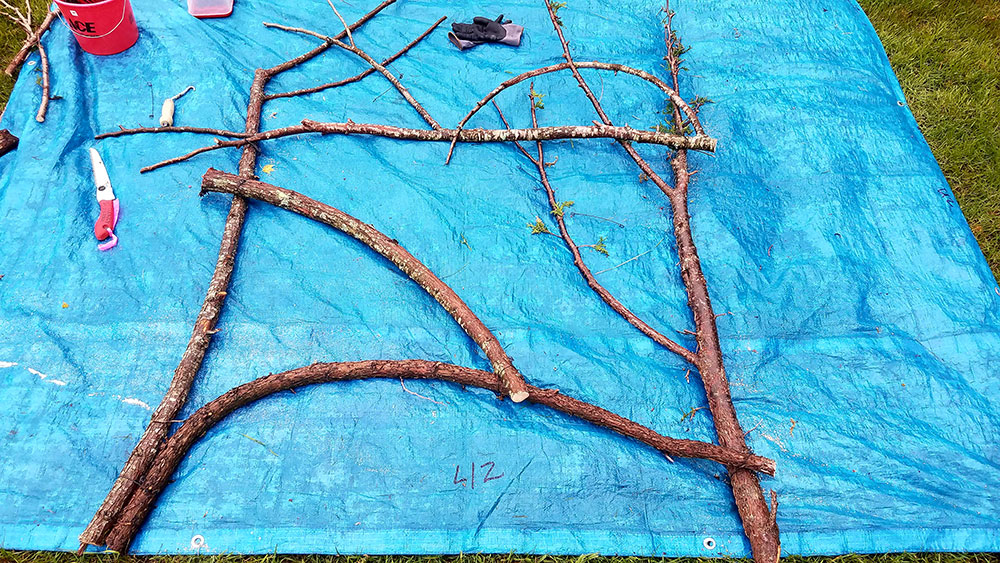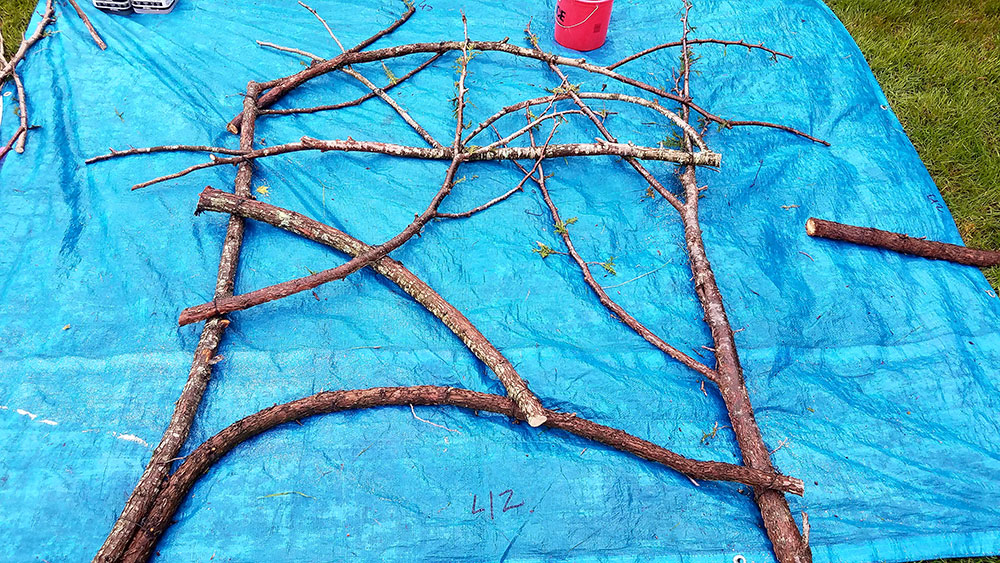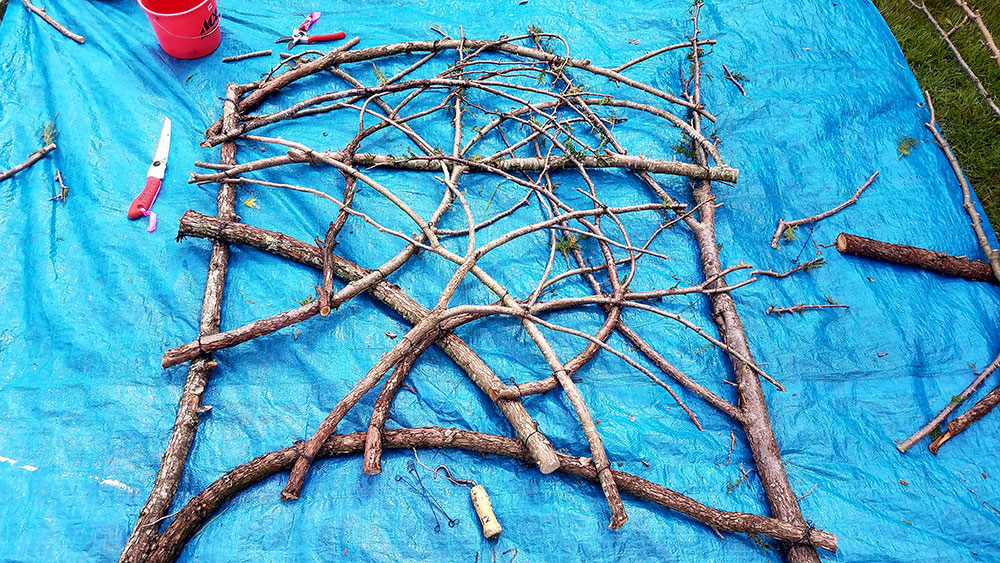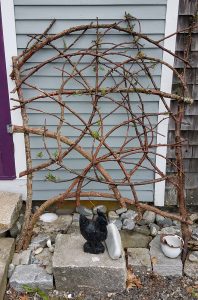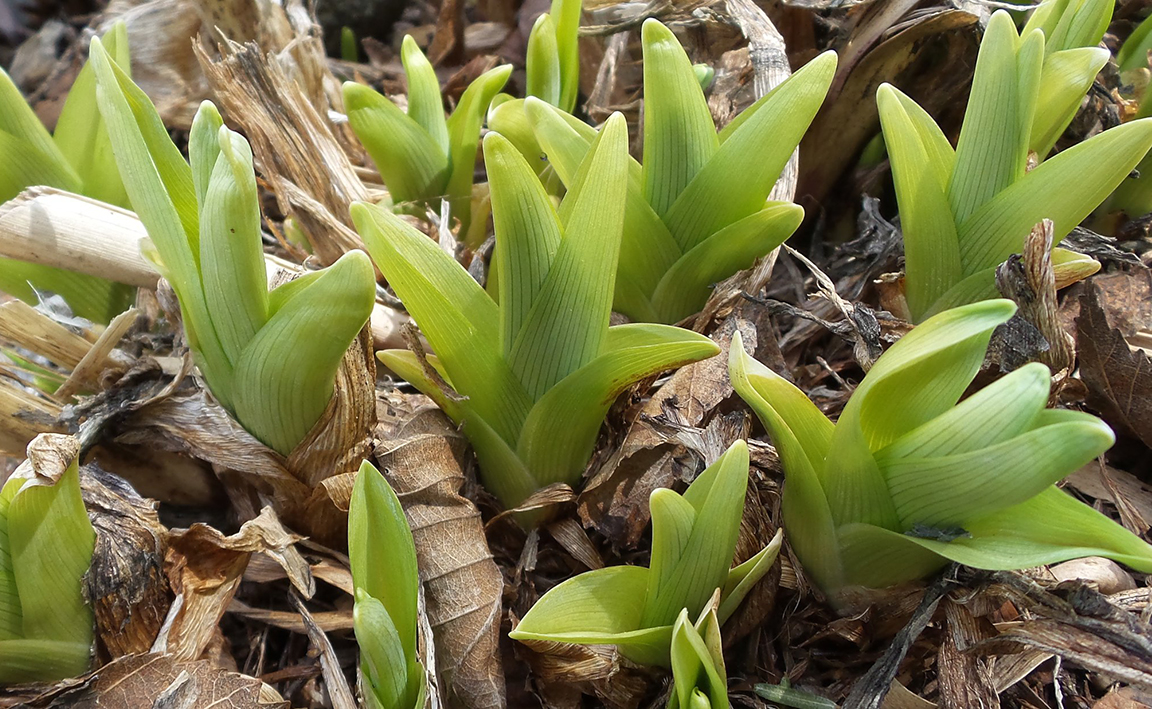
Maine Home Garden News — March 2019
- March Is the Month to . . .
- How to Make a Twiggy Trellis
- Brown Marmorated Stink Bug (BMSB), Halyomorpha halys
- Misbranded/Adulterated Pesticide Product
- Five Award-Winning Tomato Varieties to Consider
- Auburn Community Garden Initiative: Growing Community as Well as Plants
- Food & Nutrition: Cooking for Crowds — Food Safety Training for Volunteers
March Is the Month to . . .
By Frank Wertheim, Extension Educator, UMaine Extension York County
 Start your own seedlings. Consider using supplemental lighting. Sunny windows usually do not provide sufficient light and consistent temperatures for optimal seedling development. Seedlings growing in limited light and cooler temperatures develop more slowly, are often lanky, can have a less developed root system, and are more susceptible to diseases such as damping off. Learn more about Starting Your Own Seedlings at Home in our comprehensive bulletin that includes plans for building an inexpensive light stand and a handy instructional video.
Start your own seedlings. Consider using supplemental lighting. Sunny windows usually do not provide sufficient light and consistent temperatures for optimal seedling development. Seedlings growing in limited light and cooler temperatures develop more slowly, are often lanky, can have a less developed root system, and are more susceptible to diseases such as damping off. Learn more about Starting Your Own Seedlings at Home in our comprehensive bulletin that includes plans for building an inexpensive light stand and a handy instructional video.
- Get your seeds ordered. Maine has several excellent seed companies that have varieties suited to our region. Looking for advice on which varieties to choose? Check out this listing of suggested vegetable varieties for Maine gardens from the researchers at UMaine’s Highmoor Farm or explore the newest award-winning varieties promoted by All America Selections.
- Tap maple trees for making maple syrup. If you have either sugar maple or red maple on your property, you could experiment with making your own maple syrup. Trees make their own sweet sap through photosynthesis for growth and development during the spring and summer months. In the later summer and fall, maple trees virtually stop growing and begin storing excess starches throughout the sapwood, especially in cells called ray cells. In late winter/early spring, the sap is translocated back to the growing points throughout the plant. When we tap trees, we are borrowing a bit of the sugars for our own enjoyment. To learn more, see How to Tap Maple Trees and Make Maple Syrup.
- Prune out broken or crossing/rubbing branches, and remove water sprouts from deciduous trees. The lack of leaves allows a good assessment of form, and the frozen ground prevents damage to the lawn caused by dropping branches. Thin out congested shrubs by removing up to 1/4 of the oldest stems at the base. To learn more, read Pruning Woody Landscape Plants and check out the video Pruning Apple Trees, and also review the pruning section in Growing Fruit Trees in Maine.
- Gardening Internet Search Tips: There is a lot of good information available for gardeners online. However, be careful of “.com” sites that sometimes have inaccurate information. To focus your home garden searches on unbiased, research-based information, try typing “site:edu” after any of your information searches. For example, “Growing Highbush Blueberries in Maine site:edu”. This will lead you to links to sites from universities with dependable information. Also try the eXtension One Search site.
 How to Make a Twiggy Trellis
How to Make a Twiggy Trellis
By Liz Stanley, Horticulture program coordinator, UMaine Extension Knox-Lincoln County
A. Gather tools and fasteners.
- Tools for cutting wood: tape measure, pruning saw, hand pruners, loppers, gloves, and band aids.
- Fasteners for connecting twigs: sheetrock screws (1.25” and 2.5”) and double loop rebar wire ties.
- Tools for using fasteners: cordless drill with narrow bit and Phillips head driver, yo-yo for twirling rebar wire ties, and wire cutters.
- For installing trellis: 3/8” rebar or oak stakes. (Wire, yo-yos and rebar can be found where reinforced concrete supplies are sold.)
 B. Gather flexible twigs and branches in early spring. Arborvitae is rot resistant with beautiful arches (but you must snip off needles). Mix and match saplings of oak, maple, birch, alder, striped maple, red-twigged dogwood, tulip, and other freshly pruned branches.
B. Gather flexible twigs and branches in early spring. Arborvitae is rot resistant with beautiful arches (but you must snip off needles). Mix and match saplings of oak, maple, birch, alder, striped maple, red-twigged dogwood, tulip, and other freshly pruned branches.
C. Create vertical sides. Measure and cut thick sturdy posts and lay them on a tarp.
D. Measure and cut horizontal pieces. Secure these larger pieces with screws. If necessary, pre-drill holes to prevent splitting.
E. Add diagonal braces for strength. Use screws or double loop rebar wire ties. (It’s fun for adults and kids to learn the technique for using a yo-yo and wire ties!)
F. Fill in trellis with decorative patterns. Secure crossing intersections. If longer wire is needed, connect ties together. Pick up the trellis and look at it as you work. The trellis should be strong and rigid.
- Step C
- Step D
- Step E
- Step F
G. Place your finished trellis. Pound two 4-5’ rebar (or stakes) into the ground and wire the verticals to it. To prevent rot, suspend ends off the ground or place on a brick. Plant clematis or other vines, or use as a fence or screen.
H. Enjoy your trellis year round. They can last for 10 years if made from arborvitae.
Many thanks to Master Gardener Volunteer Linda Redman for teaching so many of us how to make these fun and beautiful garden accessories.
Misbranded/Adulterated Pesticide Product
Maine Department of Agriculture, Conservation and Forestry, Board of Pesticides Control
The Oregon Department of Agriculture (ODA) has ordered the stoppage of sale and
distribution of a pesticide product manufactured by Southern Agriculture Insecticides Inc., after finding the presence of three pesticide active ingredients not listed on the product label. Triple Action Neem Oil Broad Spectrum Fungicide, Insecticide, Miticide is labeled for use on house plants, trees and shrubs, fruits and vegetables, and lawns, and for use in and around homes and home gardens.
The label lists the only active ingredient as “Neem Oil,” and may be identified by the EPA Reg. No. 70051-2-829. This product is listed for Organic use by the Organic Materials Review Institute (OMRI). Actions came following an investigation of the product and laboratory analysis that found the presence of the active ingredients malathion, chlorpyrifos, and permethrin, which are not listed on the label.
This product is currently registered in Maine. It is prohibited from use for commercial marijuana production. All other growers who may have purchased the product are being asked to refrain from using it.
For more information about the Board of Pesticides Control, visit thinkfirstspraylast.org.
Brown Marmorated Stink Bug (BMSB), Halyomorpha halys
From the Maine Department of Agriculture, Conservation and Forestry
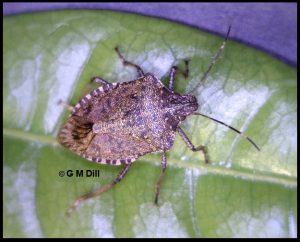
The invasive brown marmorated stink bug (BMSB; Halyomorpha halys) was first discovered in Pennsylvania in 2001, and has caused tremendous crop damage in many mid-Atlantic states. Two to three years prior to noticeable crop damage, BMSB may be seen overwintering in people’s homes often in large numbers. As of 2017, reports of BMSB overwintering in Maine structures have been verified from 67 towns in 12 counties. Reports of overwintering populations help experts predict and prepare for subsequent potential crop damage.
If you believe you have seen this bug in your house, office, garage, etc., please take a photo of it and make a report. We DO NOT need any more reports from towns that have more than 10 verified reports (e.g. Auburn, Berwick, Biddeford, Brunswick, Gorham, Portland, Saco, etc.). See current map of reported sightings here.
- Identifying BMSB: All life stages
- Look-alikes: Many bugs look like the BMSB
- Plants that BMSB attacks
- Report the brown marmorated stink bug (a photo of the bug is needed to use this form).
- Learn more: Includes latest research on managing BMSB
Five Award-Winning Tomato Varieties to Consider
By Kate Garland, Horticulturist, UMaine Extension Penobscot County, with tomato variety descriptions and photos courtesy of All-America Selections.
Many great gardeners get their start by growing tomatoes. There’s something about that juicy fruit, warmed by the summer sun and easily preserved for enjoyment during the winter months, that sparks a passion and excitement in a great number of gardeners. I always love hearing reviews about favorite tomato varieties and feel lucky to get a chance to try out new award-winning varieties in our All-America Selections (AAS) Demonstration Garden at Rogers Farm in Old Town. If you’re looking for something new, here are 5 AAS winners to consider trying this year:
 Tomato Chef’s Choice Orange F1
Tomato Chef’s Choice Orange F1
2014 AAS Edible – Vegetable Winner
Chef’s Choice Orange F1 is a hybrid derived from the popular heirloom Amana Orange which matures late in the season. Now you can experience the wonderful flavor of an orange heirloom tomato in only 75 days from transplant. Its disease resistance is an added bonus. Chef’s Choice Orange has a wonderfully bright, almost neon, internal color and superior flesh taste and texture for an early maturing orange tomato. Excellent for soups and sauces because the intense color does not fade or discolor when cooked. Home chefs are going to love cooking with this variety as well as eating it fresh.
Average size fruits are 12 ounces but can weigh up to 1 pound. Large 5-foot-tall plants are indeterminate and the leaves cover fruit well to protect from sunburn.
Tomato Juliet F1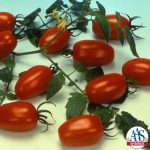
1999 AAS Edible – Vegetable Winner
The 1-ounce tomatoes are produced in clusters like grapes on the long vigorous indeterminate vines. The fruit shape is unusual, an elongated cherry type, easy to hold for cutting. The sweet flavor is welcome with glossy red skin. The improved quality is the crack resistance. Juliet tomatoes do not crack, waiting for your harvest. Grow several vines this summer or fall.
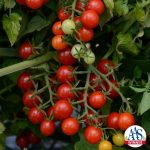 Tomato Candyland Red
Tomato Candyland Red
2016 Edible – Vegetable Winner
Tomato Candyland Red is the only AAS award winning currant-type tomato. Currant tomatoes are smaller in size than cherry-type and are ready to “pop” in your mouth straight from the garden. Gardeners will appreciate the dark red, sweet flavored fruit that can be enjoyed throughout the season. The tomato plant itself has a nice tidier habit than other currant-type plants with the fruit tending to form on the outside of the plant making them easier to harvest.
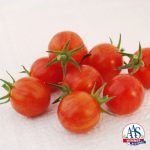 Tomato Sparky XSL F1
Tomato Sparky XSL F1
2019 AAS Edible-Vegetable Winner
Sparky is one of the few X-tended Shelf Life (XSL) cherry tomatoes available to home gardeners. Sparky brags about being early to mature, prolific, and very flavorful. Fruits are well suited for market growers and produce a large number of usable fruits per plant. You’ll enjoy gardening with these plants that have excellent tolerance to environmental stresses like heat and harsh growing conditions. Very sweet fruits have an average Brix score of 8.5. Round fruits weigh 1 ounce and are 1inch in diameter. Indeterminate 5-6’ plants produce fruits 60-70 days from transplant.
 Tomato, cocktail Red Racer F1
Tomato, cocktail Red Racer F1
2018 AAS Edible – Vegetable Winner
Red Racer, a cocktail size tomato, produced small, uniform fruits with great taste in the AAS Trials. Cocktail tomatoes have a good sweet/acid balance and are a smaller variety tomato (although larger than cherry or grape tomatoes). These tomatoes are uniform in size and mature as a cluster of fruits. The compact determinate plants produced a huge yield 7-10 days earlier than the comparisons and are ideal for small space and container gardens. One judge summed up this winner saying, “Red Racer is small in size but big in taste!” Available in both organic and conventional seeds.
Auburn Community Garden Initiative: Growing Community as Well as Plants
By Lynne Holland, Community Education Assistant, UMaine Extension Androscoggin and Sagadahoc Counties
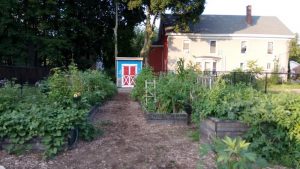
A garden by its nature is a growing thing. It is impossible to characterize it at exactly one point in time and decide “it’s done.” The Auburn Community Gardens Initiative is a perfect example of this. This garden project was conceived in 2014, implemented in Spring of 2016, and now is readying its third garden for later this year. A product of the collaboration between the city of Auburn, the Androscoggin Land Trust, the UMaine Cooperative Extension, Saint Mary’s Nutrition Center, and community residents, these gardens continue to grow not just food but also a sense of community in Auburn.
The process has not always been linear, but more like a meandering garden path. Garden sites were located on properties that city officials thought would best make the transformation from an empty lot to a community garden. A three-year Community Block Development Grant through the City of Auburn and grants/advisement from Harvard Pilgrim Health Care Foundation and the National Parks Service provided the support needed for the initial garden on Webster Street to break ground in April 2016 and host its first Harvest Potluck that fall. This garden is located in a walkable neighborhood near a downtown in close proximity to low-income housing, Head Start, and the Auburn PAL Center. The lively collection of 24 raised beds assumed its place as yet another part of this already vibrant and diverse community.
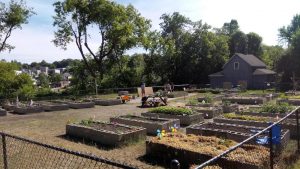
The learning process for this first garden determined criterion for the next community garden that opened in 2018 — a collection of 40 raised beds sited on Newbury St. in the New Auburn area overlooking the river. They were even able to convert an existing large concrete area to a spot for wheelchair accessible raised beds. There’s room for expansion here for future “common plots” as well as pollinator and other specialty gardens, or perhaps even fruit trees.
Plans are in place for the newest community garden site on Whitney Street to begin construction in late 2019 and be ready for planting in spring 2020.

All community garden sites in the Auburn Community Gardens Initiative are now built on city-owned properties, usually the former site of a condemned building or “tear down.” There is a commitment to making sure that the garden is set for success from the start by doing the following:
- All gardens are fenced in to cut down on four-legged marauders. A large gate allows for truck deliveries of mulch, compost, and other supplies.
- The garden beds are all raised beds to allow for new soil and amendments.
- Connection to city water guarantees availability of water even in a drought.
- Subsidized or free plants are often available from various community resources.
- A shed, complete with tools, is included in each garden.
- Plot cost per family is nominal.
- Plot holders are expected to volunteer to help with the whole garden and 80% do.
- A garden coordinator is available to oversee the two, soon to be three, gardens. Charis Heisey helps gardeners with “open garden” weekly events and also keeps an eye on pests, watering and problems so they can be dealt with quickly and organically.
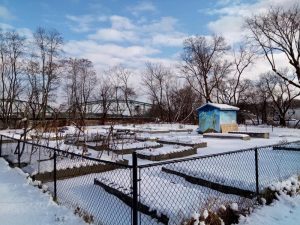
In 2019, the current gardens will get kiosks on site to hold garden bulletins as well as act as areas of communication between the gardeners, the communities, and the city. To watch the progress of the Auburn Community Garden Initiative you can follow their Facebook Page. If you are interested in a plot at the gardens or helping at the gardens you can contact Charis Heisey, the Community Garden Coordinator.
Food & Nutrition: Cooking for Crowds — Food Safety Training for Volunteers
By Kathy Savoie, MS, RD, UMaine Extension Cumberland County
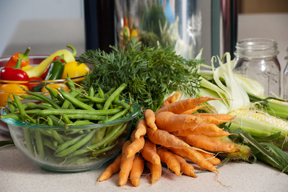 Many organizations and community groups rely on volunteers for a variety of food events for fundraising, fellowship, food pantries or other service to the community. But cooking for a crowd is tricky! How do you store all that food? When is the food completely cooked? How long can you leave food on the serving table? UMaine Cooperative Extension offers a workshop on safe food handling designed specifically for volunteers. Visit Cooking for Crowds to learn more about workshop dates or to request a workshop in your area.
Many organizations and community groups rely on volunteers for a variety of food events for fundraising, fellowship, food pantries or other service to the community. But cooking for a crowd is tricky! How do you store all that food? When is the food completely cooked? How long can you leave food on the serving table? UMaine Cooperative Extension offers a workshop on safe food handling designed specifically for volunteers. Visit Cooking for Crowds to learn more about workshop dates or to request a workshop in your area.
This class meets the Good Shepherd Food Bank food safety training requirements.
There’s a lot to learn about safe food preparation and handling. If you don’t do it for a living, you may not be aware of all the special techniques involved in cooking for a large group of people. It’s scary to think about people getting sick from your meal, but it can happen. More than three-quarters of foodborne outbreaks are blamed on food eaten outside the home.
This workshop covers the following food safety guidelines:
- Planning and Purchasing
- Storing Food Supplies
- Preparing Food
- Transporting, Storing and Serving Cooked Foods
- Handling Leftovers
You will learn up-to-date methods for safely preparing, handling, and serving food for large group functions such as soup kitchens, church functions, and community events. Participants receive the Cooking for Crowds manual, Certificate of Attendance, posters, and instant read thermometers.
University of Maine Cooperative Extension’s Maine Home Garden News is designed to equip home gardeners with practical, timely information.
Let us know if you would like to be notified when new issues are posted. To receive e-mail notifications fill out our online form.
For more information or questions, contact Kate Garland at katherine.garland@maine.edu or 1.800.287.1485 (in Maine).
Visit our Archives to see past issues.
Maine Home Garden News was created in response to a continued increase in requests for information on gardening and includes timely and seasonal tips, as well as research-based articles on all aspects of gardening. Articles are written by UMaine Extension specialists, educators, and horticulture professionals, as well as Master Gardener Volunteers from around Maine, with Katherine Garland, UMaine Extension Horticulturalist in Penobscot County, serving as editor.
Information in this publication is provided purely for educational purposes. No responsibility is assumed for any problems associated with the use of products or services mentioned. No endorsement of products or companies is intended, nor is criticism of unnamed products or companies implied.
© 2019
Call 800.287.0274 (in Maine), or 207.581.3188, for information on publications and program offerings from University of Maine Cooperative Extension, or visit extension.umaine.edu.

